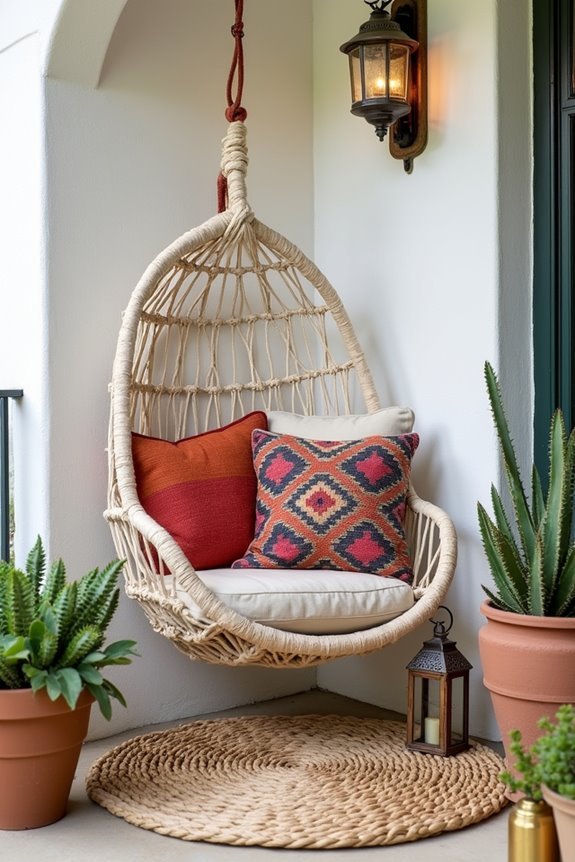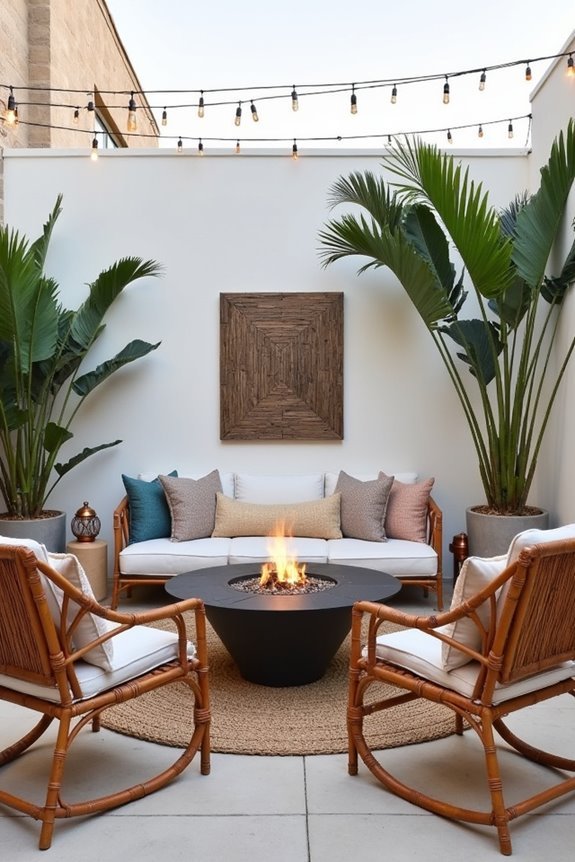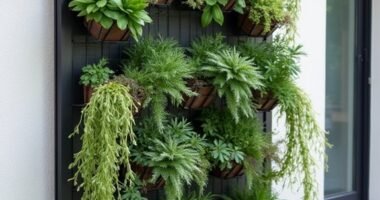Transform your outdoor space with versatile hanging planters that add charm and greenery without taking up floor space. Try macramé hangers for a boho vibe, repurposed teacups for vintage elegance, or colorful painted tin cans for a bright pop of personality. Vertical herb gardens bring fresh flavors to your kitchen, while cascading flower baskets create dramatic visual impact. With these creative ideas, you’ll discover endless possibilities to elevate your garden’s beauty and functionality.
Key Takeaways
- Macramé plant hangers provide a bohemian aesthetic for displaying trailing plants like pothos while being accessible for DIY crafters.
- Upcycled wine bottles can be transformed into elegant hanging planters ideal for herbs and succulents with proper cutting techniques.
- Cascading flower baskets create dramatic visual impact when filled with varying bloom-period plants like petunias, lobelia, and verbena.
- Repurposed vintage teacups and driftwood arrangements offer unique, eco-friendly options for small plants and coastal-themed outdoor spaces.
- Colorful painted tin cans with proper drainage provide an inexpensive way to create vibrant hanging displays at various heights.
Macramé Plant Hangers for Boho Charm
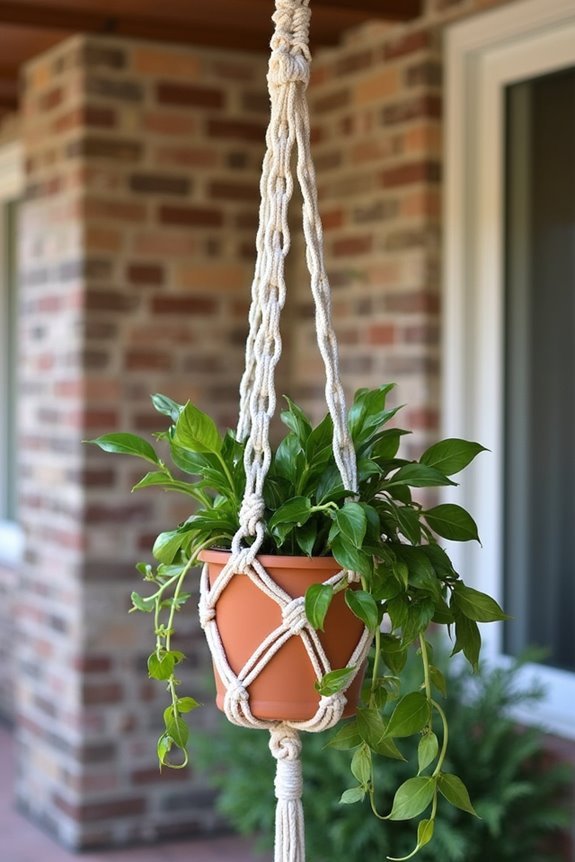
While many plant hanging options exist, macramé hangers have surged in popularity for their distinctive, bohemian aesthetic. These beautiful woven creations add texture and warmth to your space, transforming ordinary plants into striking decorative features. You’ll find them in various designs, from simple patterns perfect for beginners to elaborate creations that become conversation pieces. Outdoor hanging planters offer endless possibilities for vertical gardening and maximizing space. Creating arrangements at varying heights adds visual interest and depth to your outdoor display.
What makes macramé so special is its versatility. You can choose natural cotton rope for a classic look, or colored cords to match your décor. They’re perfect for displaying trailing plants like pothos, spider plants, or string of pearls, whose cascading tendrils complement the knotted designs. If you’re feeling crafty, you’ll find plenty of beginner-friendly tutorials online to create your own custom hangers that reflect your personal style. Stylish macrame planters can instantly elevate any outdoor space with their handcrafted appeal.
Repurposed Vintage Teacups as Mini Planters
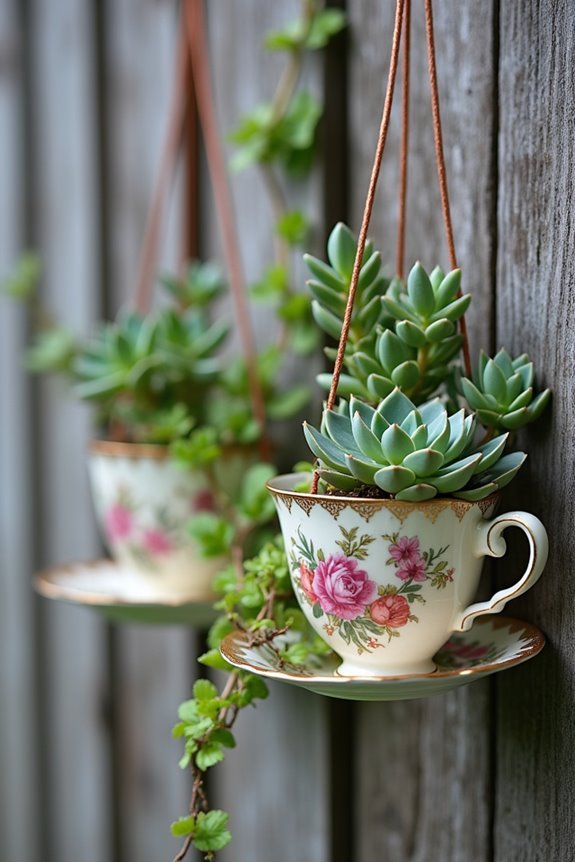
The humble teacup, often forgotten in china cabinets or thrift stores, can transform into a charming mini planter with just a touch of creativity. These delicate vessels bring a touch of vintage elegance to your hanging garden while giving new life to treasured pieces that might otherwise gather dust. Much like vertical gardening solutions discussed in traditional trellis designs, hanging teacup planters maximize your available garden space in a uniquely decorative way. Creating a living wall display with multiple teacup planters adds visual interest to small outdoor spaces while maintaining a cohesive design theme.
Your teacup transformation journey is simpler than you might think:
- Choose teacups with interesting patterns or colors that complement your home décor
- Drill a small drainage hole in the bottom using a ceramic drill bit, or add a layer of pebbles if you’d prefer not to drill
- Attach sturdy chains or decorative ribbon to the handle and secure with strong adhesive or small hooks for hanging
These whimsical planters work beautifully with small succulents, air plants, or trailing ivy that won’t outgrow their dainty new homes. Adding teacup planters is one of many garden art projects that can instantly add personality and charm to your outdoor space.
Hanging Herb Gardens for Fresh Culinary Ingredients
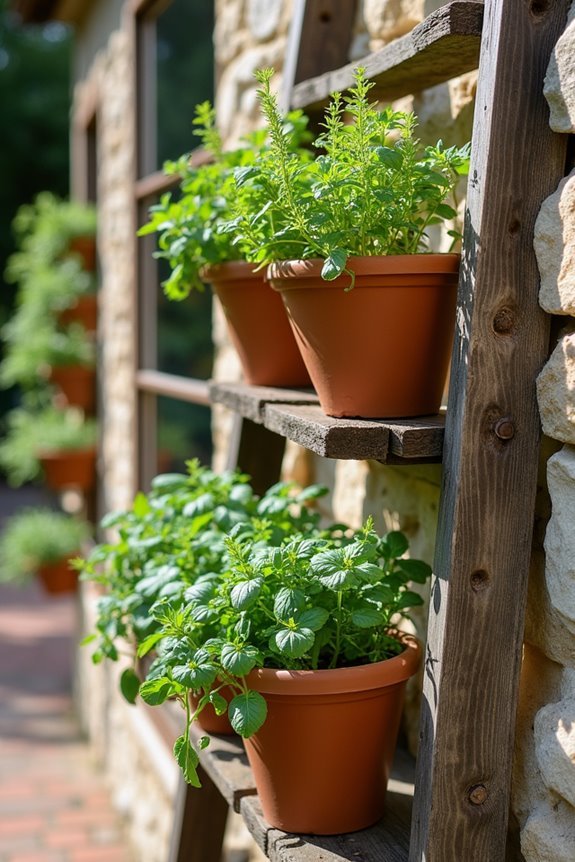
Three essential benefits make hanging herb gardens a perfect addition to your culinary space: convenience, freshness, and beauty. You’ll love having basil, mint, and rosemary within arm’s reach while cooking, saving you trips to the store and money on store-bought herbs.
Choose lightweight containers with proper drainage, and arrange herbs according to their sunlight needs. Herbs like thyme and oregano prefer full sun, while mint and parsley can handle partial shade. Mount your garden near a kitchen window or on your patio where you’ll see and use it daily. Balcony planters can transform even the smallest outdoor areas into productive growing spaces. Creating an outdoor oasis with hanging herbs adds both functionality and natural charm to your garden space.
Don’t forget to label each plant with cute markers! Your hanging herb garden will become both a practical kitchen tool and a living decoration that fills your space with wonderful aromas and vibrant greens.
Consider adding chic hanging planters to create visual interest and maximize your growing space while maintaining a stylish garden aesthetic.
Colorful Painted Tin Can Planters
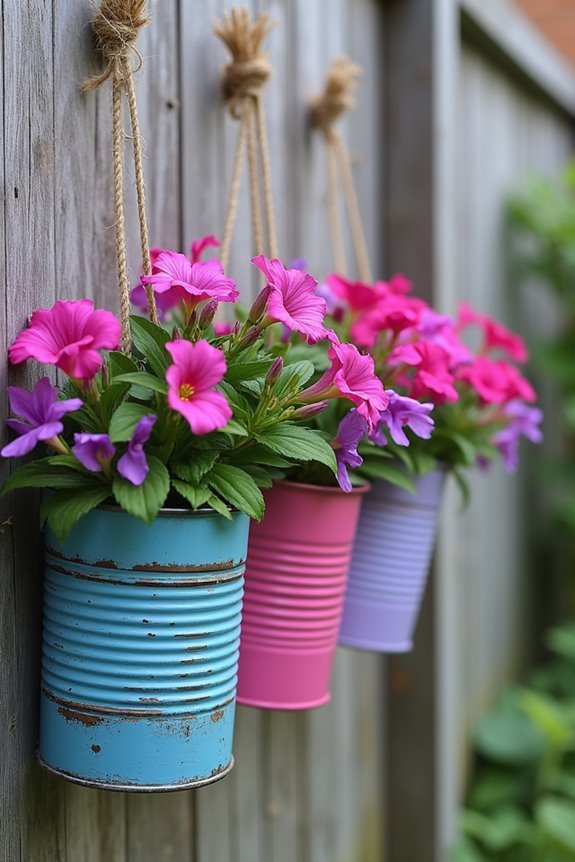
Transforming ordinary tin cans into colorful hanging planters offers a perfect blend of sustainability, creativity, and charm for your home. These eco-friendly containers, which might otherwise end up in landfills, can become stunning vertical garden elements with just a few supplies and a bit of imagination.
- Prepare your cans by removing labels, washing thoroughly, and drilling drainage holes in the bottom before sanding any sharp edges for safety.
- Apply a metal primer first, then use weather-resistant acrylic paints in your favorite colors – try patterns like stripes, polka dots, or ombré effects for visual interest.
- Attach sturdy wire or rope through holes punched near the rim, creating a secure hanging mechanism that complements your design scheme.
You’ll love how these bright, personalized planters instantly elevate your outdoor space! Consider creating a DIY hanging planter arrangement with multiple cans at varying heights for added visual impact.
Vertical Succulent Wall Arrangements

Vertical succulent walls transform ordinary spaces into living works of art while maximizing your gardening area in even the smallest homes. You’ll love how these arrangements combine various succulent shapes, colors, and textures to create stunning visual interest that draws everyone’s attention.
To create your own, start with a frame or panel with small compartments or pockets, then add well-draining soil mix specifically for succulents. Choose a variety of plants with different heights and colors, placing larger varieties at the bottom and cascading types near the edges. Water sparingly, as succulents don’t need much moisture to thrive.
The best part? These living walls require minimal maintenance once established. You’ll enjoy their beauty for months with just occasional watering and a bit of sunlight.
Hanging Glass Terrariums for Air Plants

Suspended from ceilings or hanging near windows, glass terrariums housing air plants create a magical, floating garden effect in any room of your home. These low-maintenance beauties don’t need soil, making them perfect companions for clear glass containers that showcase their unique forms. You’ll love how these ethereal displays catch light and create delicate shadows throughout your space.
- Choose geometric or round glass containers with openings large enough for air circulation
- Arrange colorful sand, small pebbles, or dried moss as a base to add texture and visual interest
- Mist your air plants weekly and give them a longer soak in water once a month
Creating these hanging gardens isn’t just decorative—it’s a wonderful way to bring nature’s calming presence into your daily life.
Upcycled Wine Bottle Planters
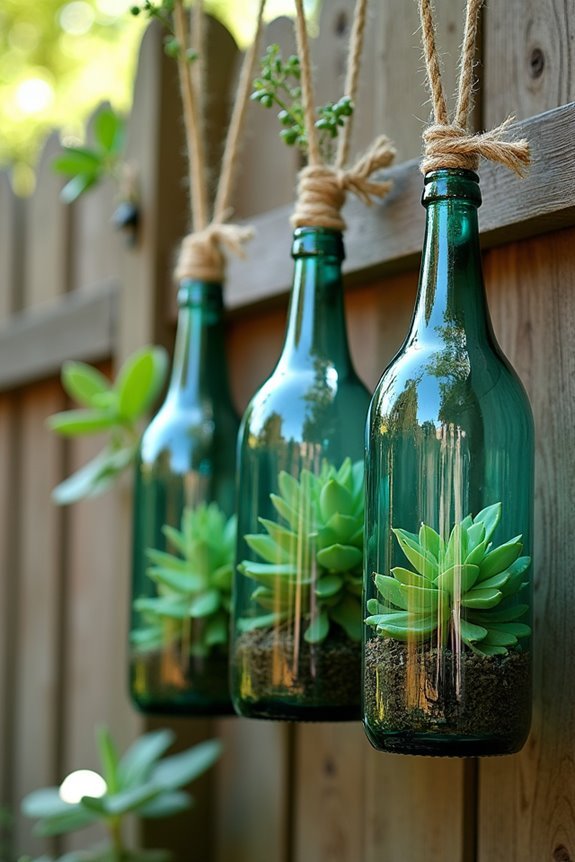
Why let those empty wine bottles go to waste when they can become stunning vertical gardens for your home? With just a few tools and some creativity, you’ll transform ordinary bottles into eye-catching planters that add charm to any space.
Start by carefully cutting the bottom of a clean wine bottle using a glass cutter tool, or try the string-and-fire method if you’re feeling adventurous. Sand the edges smooth to prevent cuts, then thread sturdy rope or wire through the neck for hanging.
You’ll love how these bottle planters catch the light, especially green or blue ones that create a magical glow when sunlight passes through. They’re perfect for small herbs, trailing vines, or succulents that don’t need much soil to thrive.
Driftwood and Rope Hanging Displays
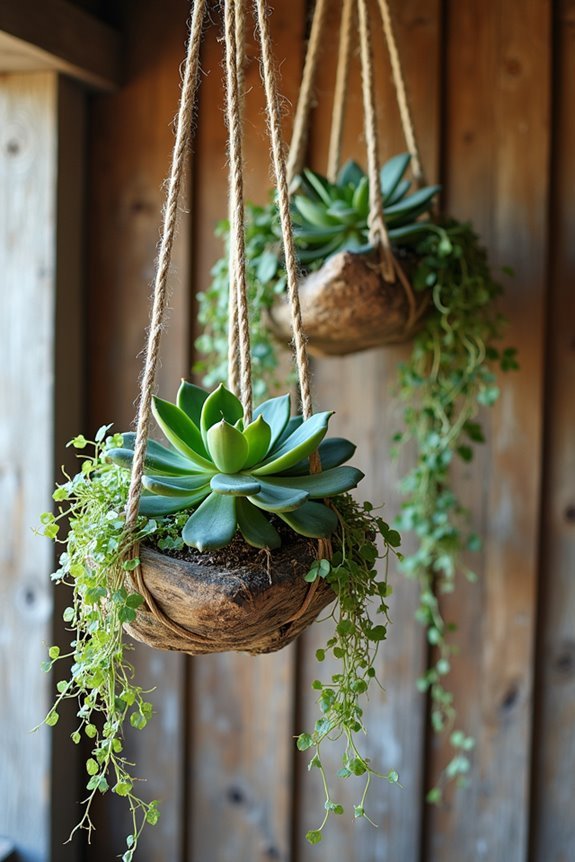
When pieces of sun-bleached driftwood wash ashore, they bring with them endless opportunities for creating stunning hanging planters that blend natural beauty with rustic charm. You’ll love how these unique pieces transform your patio or garden into a coastal-inspired retreat. The weathered textures and organic shapes of driftwood create one-of-a-kind displays that showcase your favorite plants in a memorable way.
Try these simple approaches to driftwood hanging planters:
- Drill small holes in a larger driftwood piece, insert air plants or succulents, and hang with natural twine from your porch ceiling
- Create a tiered hanging display using several driftwood pieces connected by rope for a dramatic vertical garden
- Attach miniature pots to a driftwood branch for an arrangement that looks as if it’s floating in mid-air
Cascading Flower Baskets for Dramatic Impact
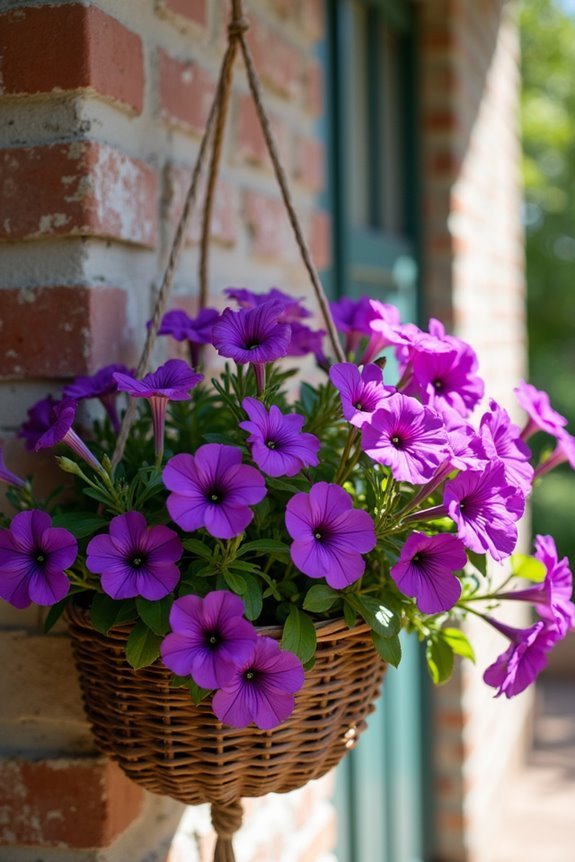
How dramatically a well-designed cascading flower basket can transform the look and feel of your outdoor space! When flowers spill over the edges and create a waterfall effect, they bring movement and life to porches, patios, and garden areas. You’ll find that these eye-catching displays become the focal point of your outdoor sanctuary.
| Plant Type | Trailing Length | Best Location |
|---|---|---|
| Petunias | Medium (8-12″) | Full sun |
| Lobelia | Short (6-8″) | Partial shade |
| Verbena | Long (12-24″) | Full sun |
Choose plants with different blooming periods to guarantee your basket stays vibrant all season. Start with a sturdy basket that’s at least 14 inches wide, and don’t skimp on quality potting mix. Remember to water frequently, as cascading baskets dry out faster than traditional planters.
Geometric Wire Frame Planters
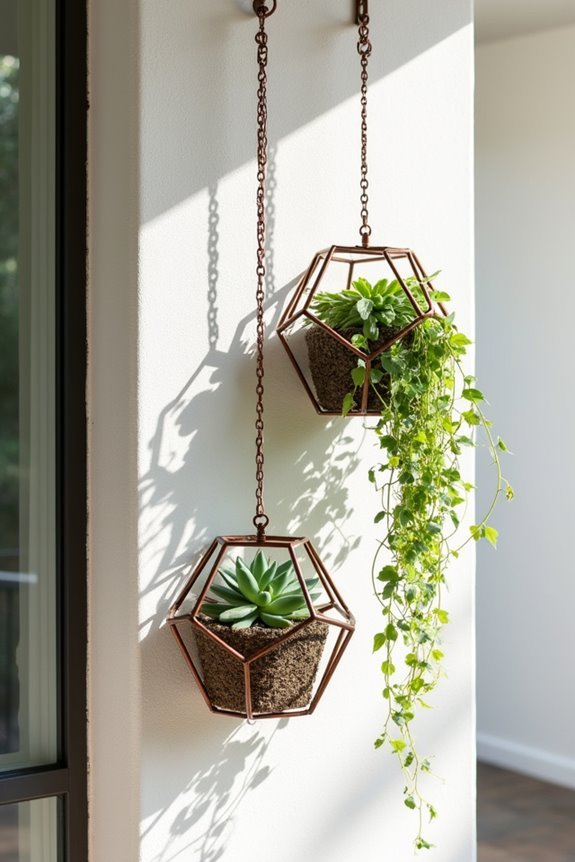
Geometric wire frame planters have become incredibly popular in modern home decor, and it’s easy to see why! These stunning containers add an artistic element to your space while showcasing your favorite plants in a unique way. You’ll love how the open design creates interesting shadows and highlights your greenery from every angle.
Try these wonderful options for your home:
- Hang a collection of diamond-shaped frames at different heights for a fascinating visual display in your sunroom or patio corner
- Select gold or copper wire planters to add warmth and elegance to your space – they’ll catch the sunlight beautifully!
- Use minimalist black wire globes for a dramatic contrast against lush, trailing plants like string of pearls or ivy
Rain Chain Planters for Dual Functionality
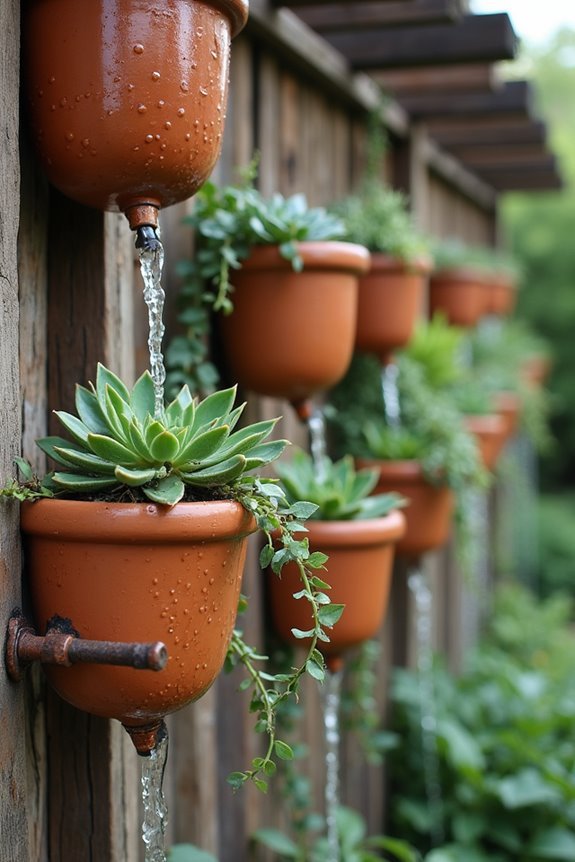
While wire frames showcase your plants with artistic flair, rain chain planters offer a beautiful blend of form and function for your outdoor space. These innovative hanging gardens direct rainwater from your roof to the ground, creating a cascading water feature when it rains. You’ll appreciate how they transform ordinary downspouts into stunning visual elements that bring joy in all weather conditions.
To create your own rain chain planter, select cups, small pots, or metal containers that complement your home’s style, then drill drainage holes in their centers. Connect them vertically using sturdy wire or chain, making sure each container hangs securely. Place water-loving plants like ferns, ivy, or small succulents in each vessel. You’ll love watching rainwater nourish your plants while creating a peaceful, tinkling waterfall effect.
Window Box Hangers for Small Balconies
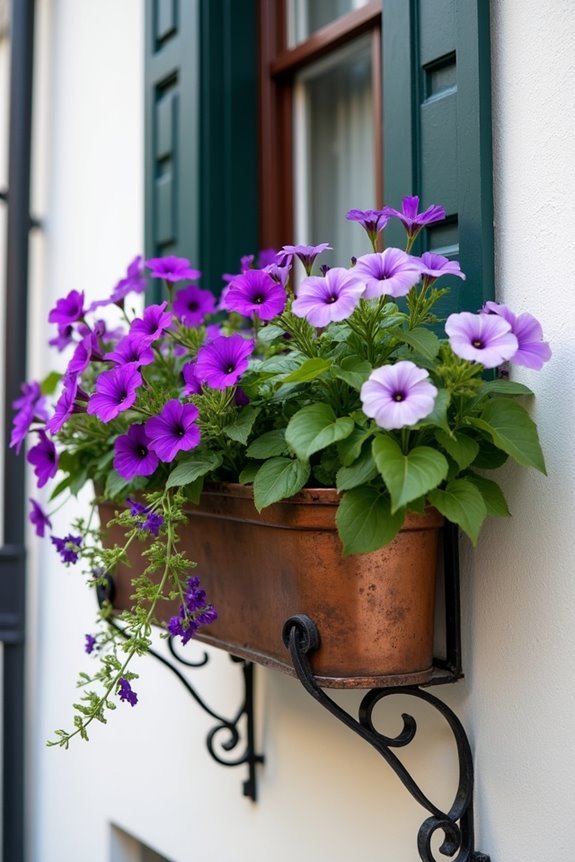
Three ingenious window box hangers can transform even the tiniest balcony into a lush, green retreat. When space is limited, these vertical gardening solutions allow you to grow flowers, herbs, and even small vegetables without sacrificing precious floor area. You’ll love how they add color and life to your outdoor nook!
- Adjustable rail hangers that clip onto balcony railings securely, with no drilling required — perfect for renters who can’t make permanent changes
- Stackable window boxes that create a vertical garden wall, maximizing your growing space while creating a stunning visual effect
- Corner-designed window boxes that fit snugly around balcony corners, utilizing often wasted space and creating a continuous flow of greenery
Rustic Wooden Crate Vertical Gardens
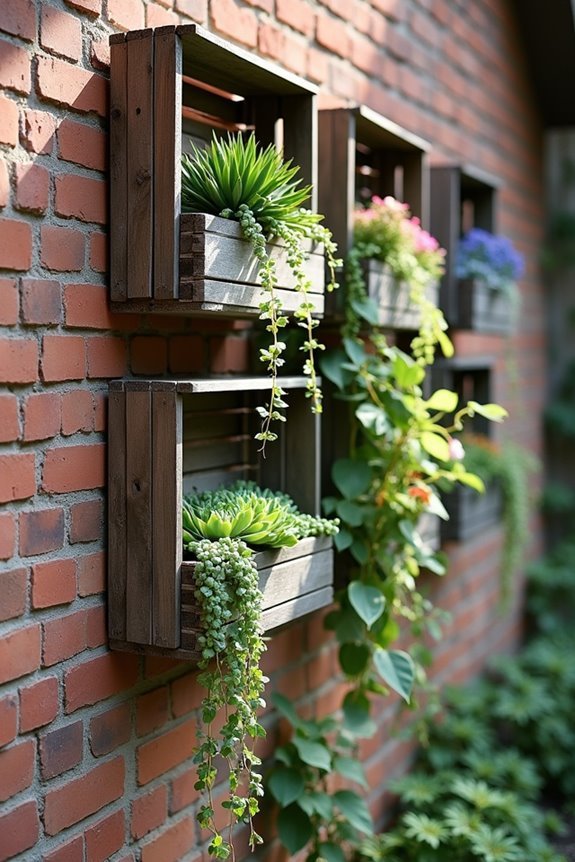
For those seeking more character and rustic charm, wooden crate vertical gardens offer a perfect upgrade from standard window boxes. You’ll love how these repurposed treasures bring warmth and texture to any outdoor space, while maximizing your growing area vertically.
Start by sourcing wooden crates from local farmers’ markets or antique stores—the more weathered, the better! Attach them securely to your fence or wall, making sure to leave enough space between each crate for plants to grow and cascade. Line the inside with landscape fabric before adding soil to prevent rot and drainage issues.
These versatile planters work beautifully with herbs, trailing flowers, and even small vegetables. You’ll create a stunning display that’s both functional and eye-catching, turning a plain wall into your garden’s most spectacular feature.
Hanging Wall Pocket Organizers for Multiple Plants
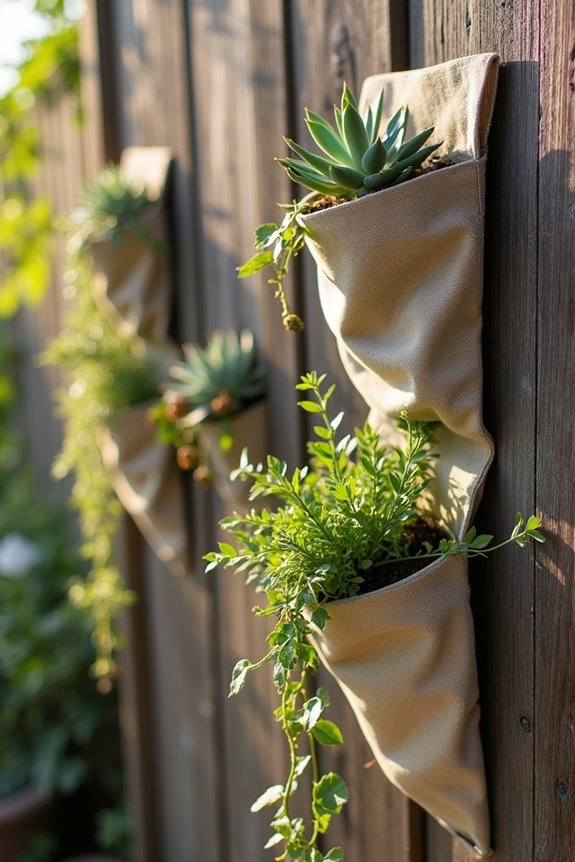
Transforming your vertical space with hanging wall pocket organizers is one of the smartest ways to display multiple plants when floor or shelf space is limited. These fabric or canvas organizers, originally designed for shoes or small items, make perfect homes for your favorite small plants and herbs. You’ll love how they instantly create a living wall that adds natural beauty to any blank space in your home or garden area.
Here are three ways to maximize your hanging pocket planters:
- Group plants with similar water needs in adjacent pockets to simplify maintenance
- Create a colorful pattern by alternating flowering and trailing plants for visual interest
- Label each pocket with cute plant markers to track your growing collection
Water management is easy too—just be sure to line fabric pockets with plastic to prevent wall damage.
Illuminated Planters With Solar Lighting
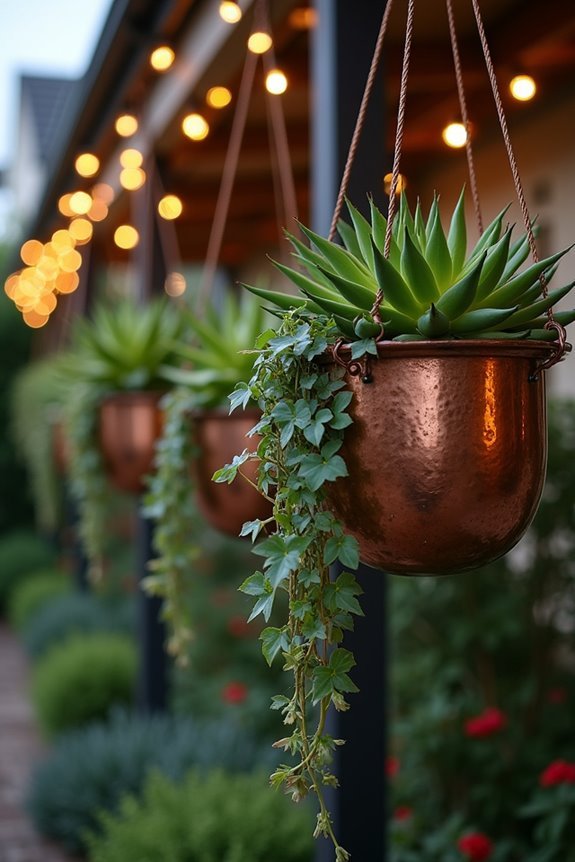
While the sun sets and darkness begins to fall, your garden can come alive with an enchanting glow when you incorporate illuminated planters with solar lighting into your outdoor spaces. These innovative planters collect sunlight during the day and transform into magical light sources at night, requiring no electrical wiring or complicated setup.
You’ll find plenty of options, from colorful LED-infused pots that change colors to elegant designs with subtle, warm lighting accents. Simply hang them from shepherd’s hooks, pergolas, or tree branches to create a mesmerizing nighttime ambiance. The solar panels are typically discreetly positioned to maximize sun exposure without compromising aesthetics.
Besides adding beauty, these illuminated planters improve safety by lighting pathways and highlight your favorite plants after dark, extending your enjoyment of the garden well into the evening.
Frequently Asked Questions
How Often Should I Water My Hanging Plants?
Your hanging plants typically need watering when the top inch of soil feels dry to the touch. During summer, you’ll likely water 2-3 times weekly, while in winter, once a week may suffice. Always check each plant’s specific needs, as tropical varieties crave more moisture than succulents. Pay attention to your plants’ signals too—drooping leaves often indicate thirst, while yellow leaves might mean you’re overwatering. Trust your instincts and adjust as needed!
What Plants Thrive Best in Hanging Planters?
Several plants thrive beautifully in hanging planters! Try pothos, spider plants, and string of pearls for their trailing vines. Ferns, especially Boston and maidenhair varieties, love the aerial position. Petunias, begonias, and lobelia offer gorgeous blooms that cascade downward. Herbs like thyme and oregano work wonderfully too, especially in sunny spots. You’ll get the best results when you match each plant’s light and water needs to your specific hanging location.
How Do I Prevent Soil From Spilling When Watering?
To prevent soil spillage when watering your hanging planters, try using a saucer or tray underneath to catch excess water and soil. You can also leave about an inch of space between the soil and the top of your planter, creating a reservoir for water to settle. Watering slowly and gently with a narrow-spouted watering can gives soil time to absorb moisture without overflowing. Adding a layer of decorative stones on top helps keep soil in place, too!
Can Hanging Planters Damage My Ceiling or Walls?
Yes, hanging planters can damage your ceiling or walls, but don’t worry, there are easy solutions! Make sure you use proper hardware designed for the weight of your planter when fully watered. Install anchors in studs or joists, not just drywall, when hanging heavier plants. Water-resistant saucers or drip trays will protect surfaces from moisture damage. With these simple precautions, you’ll enjoy your beautiful hanging garden without any structural concerns.
How Much Weight Can Different Hanging Systems Support?
Different hanging systems support varying weights, so you’ll want to choose carefully. Standard ceiling hooks can hold 5-10 pounds, perfect for small plants. Toggle bolts increase capacity to 15-20 pounds, while ceiling joists can support 30-50 pounds for your larger beauties. Wall-mounted brackets typically handle 10-25 pounds depending on installation. Always check manufacturer specifications and consider your plant’s weight when fully watered, as moisture adds significant weight to soil.



